An Analysis of Employee Engagement Strategies in Modern Organizations
VerifiedAdded on 2023/02/01
|10
|2601
|53
Report
AI Summary
This report delves into the critical role of employee engagement, empowerment, and motivation within human resource management (HRM). It emphasizes the need for innovative strategies to address employee concerns, foster a positive work environment, and drive organizational success. The report examines various strategies for engaging staff, including the importance of job design, employee surveys, job enrichment, effective recruitment and selection processes, training and development programs, and performance management. It highlights the significance of understanding individual differences and personality typologies when implementing engagement practices. Furthermore, the report underscores the worthwhile investment in employee engagement, citing its positive impact on employee performance, productivity, retention, and customer satisfaction. Ultimately, the report concludes that prioritizing employee well-being leads to increased organizational success, emphasizing that when a company cares for its employees, the employees reciprocate with greater dedication and commitment.

Running head: LEADING AND MANAGING ORGANISATIONS
LEADING AND MANAGING ORGANISATIONS
Name of the student:
Name of the university:
Author note:
LEADING AND MANAGING ORGANISATIONS
Name of the student:
Name of the university:
Author note:
Paraphrase This Document
Need a fresh take? Get an instant paraphrase of this document with our AI Paraphraser
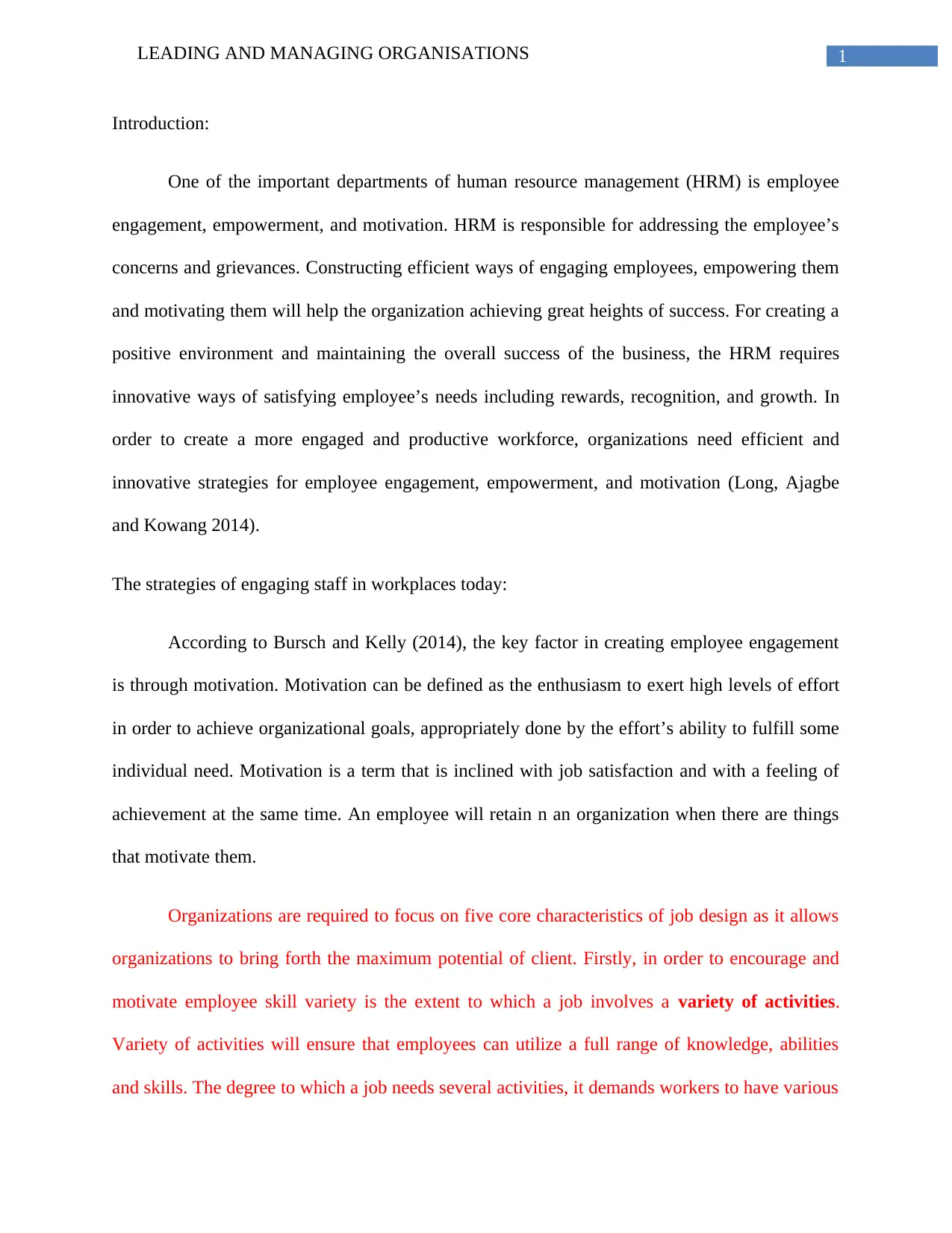
1LEADING AND MANAGING ORGANISATIONS
Introduction:
One of the important departments of human resource management (HRM) is employee
engagement, empowerment, and motivation. HRM is responsible for addressing the employee’s
concerns and grievances. Constructing efficient ways of engaging employees, empowering them
and motivating them will help the organization achieving great heights of success. For creating a
positive environment and maintaining the overall success of the business, the HRM requires
innovative ways of satisfying employee’s needs including rewards, recognition, and growth. In
order to create a more engaged and productive workforce, organizations need efficient and
innovative strategies for employee engagement, empowerment, and motivation (Long, Ajagbe
and Kowang 2014).
The strategies of engaging staff in workplaces today:
According to Bursch and Kelly (2014), the key factor in creating employee engagement
is through motivation. Motivation can be defined as the enthusiasm to exert high levels of effort
in order to achieve organizational goals, appropriately done by the effort’s ability to fulfill some
individual need. Motivation is a term that is inclined with job satisfaction and with a feeling of
achievement at the same time. An employee will retain n an organization when there are things
that motivate them.
Organizations are required to focus on five core characteristics of job design as it allows
organizations to bring forth the maximum potential of client. Firstly, in order to encourage and
motivate employee skill variety is the extent to which a job involves a variety of activities.
Variety of activities will ensure that employees can utilize a full range of knowledge, abilities
and skills. The degree to which a job needs several activities, it demands workers to have various
Introduction:
One of the important departments of human resource management (HRM) is employee
engagement, empowerment, and motivation. HRM is responsible for addressing the employee’s
concerns and grievances. Constructing efficient ways of engaging employees, empowering them
and motivating them will help the organization achieving great heights of success. For creating a
positive environment and maintaining the overall success of the business, the HRM requires
innovative ways of satisfying employee’s needs including rewards, recognition, and growth. In
order to create a more engaged and productive workforce, organizations need efficient and
innovative strategies for employee engagement, empowerment, and motivation (Long, Ajagbe
and Kowang 2014).
The strategies of engaging staff in workplaces today:
According to Bursch and Kelly (2014), the key factor in creating employee engagement
is through motivation. Motivation can be defined as the enthusiasm to exert high levels of effort
in order to achieve organizational goals, appropriately done by the effort’s ability to fulfill some
individual need. Motivation is a term that is inclined with job satisfaction and with a feeling of
achievement at the same time. An employee will retain n an organization when there are things
that motivate them.
Organizations are required to focus on five core characteristics of job design as it allows
organizations to bring forth the maximum potential of client. Firstly, in order to encourage and
motivate employee skill variety is the extent to which a job involves a variety of activities.
Variety of activities will ensure that employees can utilize a full range of knowledge, abilities
and skills. The degree to which a job needs several activities, it demands workers to have various
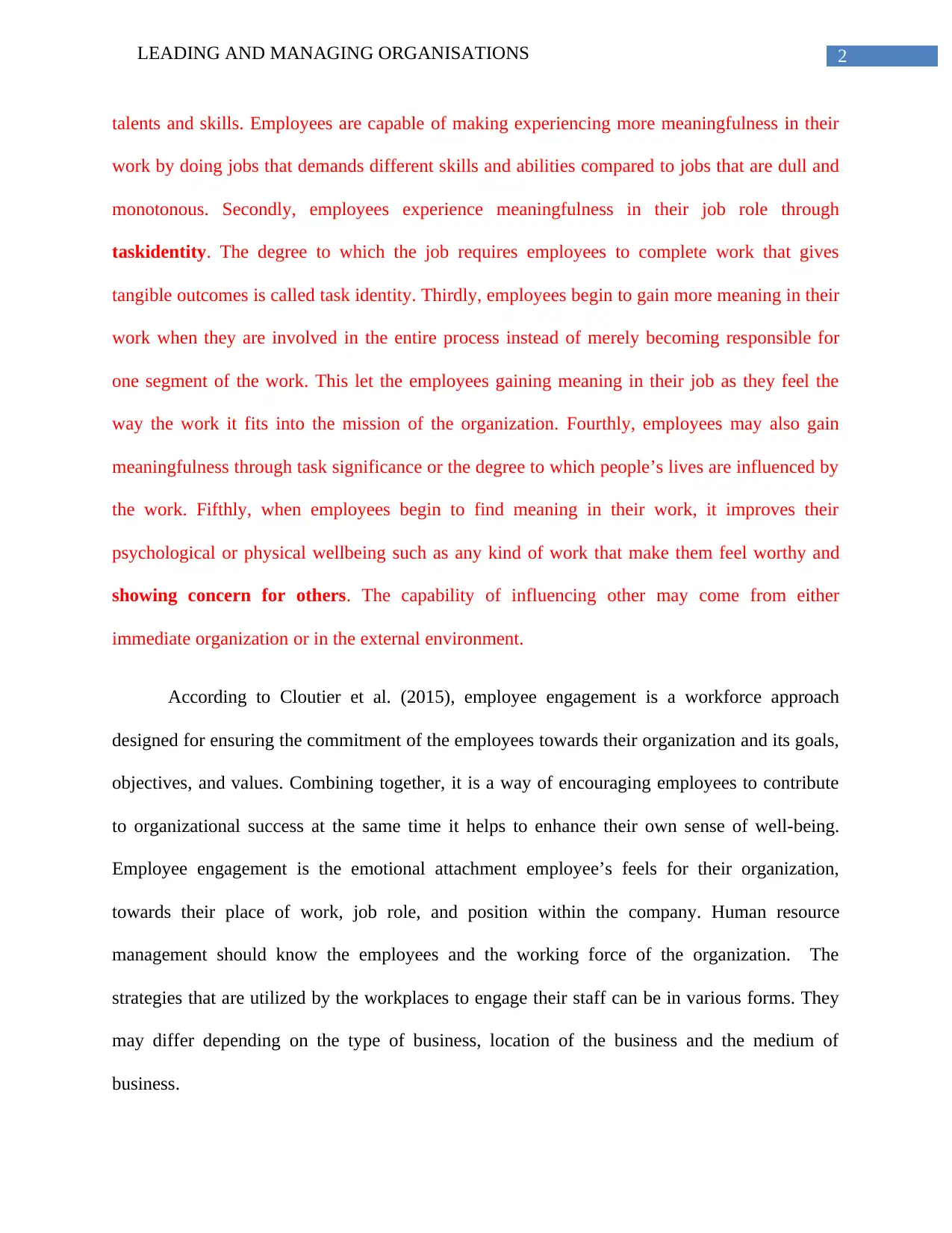
2LEADING AND MANAGING ORGANISATIONS
talents and skills. Employees are capable of making experiencing more meaningfulness in their
work by doing jobs that demands different skills and abilities compared to jobs that are dull and
monotonous. Secondly, employees experience meaningfulness in their job role through
taskidentity. The degree to which the job requires employees to complete work that gives
tangible outcomes is called task identity. Thirdly, employees begin to gain more meaning in their
work when they are involved in the entire process instead of merely becoming responsible for
one segment of the work. This let the employees gaining meaning in their job as they feel the
way the work it fits into the mission of the organization. Fourthly, employees may also gain
meaningfulness through task significance or the degree to which people’s lives are influenced by
the work. Fifthly, when employees begin to find meaning in their work, it improves their
psychological or physical wellbeing such as any kind of work that make them feel worthy and
showing concern for others. The capability of influencing other may come from either
immediate organization or in the external environment.
According to Cloutier et al. (2015), employee engagement is a workforce approach
designed for ensuring the commitment of the employees towards their organization and its goals,
objectives, and values. Combining together, it is a way of encouraging employees to contribute
to organizational success at the same time it helps to enhance their own sense of well-being.
Employee engagement is the emotional attachment employee’s feels for their organization,
towards their place of work, job role, and position within the company. Human resource
management should know the employees and the working force of the organization. The
strategies that are utilized by the workplaces to engage their staff can be in various forms. They
may differ depending on the type of business, location of the business and the medium of
business.
talents and skills. Employees are capable of making experiencing more meaningfulness in their
work by doing jobs that demands different skills and abilities compared to jobs that are dull and
monotonous. Secondly, employees experience meaningfulness in their job role through
taskidentity. The degree to which the job requires employees to complete work that gives
tangible outcomes is called task identity. Thirdly, employees begin to gain more meaning in their
work when they are involved in the entire process instead of merely becoming responsible for
one segment of the work. This let the employees gaining meaning in their job as they feel the
way the work it fits into the mission of the organization. Fourthly, employees may also gain
meaningfulness through task significance or the degree to which people’s lives are influenced by
the work. Fifthly, when employees begin to find meaning in their work, it improves their
psychological or physical wellbeing such as any kind of work that make them feel worthy and
showing concern for others. The capability of influencing other may come from either
immediate organization or in the external environment.
According to Cloutier et al. (2015), employee engagement is a workforce approach
designed for ensuring the commitment of the employees towards their organization and its goals,
objectives, and values. Combining together, it is a way of encouraging employees to contribute
to organizational success at the same time it helps to enhance their own sense of well-being.
Employee engagement is the emotional attachment employee’s feels for their organization,
towards their place of work, job role, and position within the company. Human resource
management should know the employees and the working force of the organization. The
strategies that are utilized by the workplaces to engage their staff can be in various forms. They
may differ depending on the type of business, location of the business and the medium of
business.
⊘ This is a preview!⊘
Do you want full access?
Subscribe today to unlock all pages.

Trusted by 1+ million students worldwide
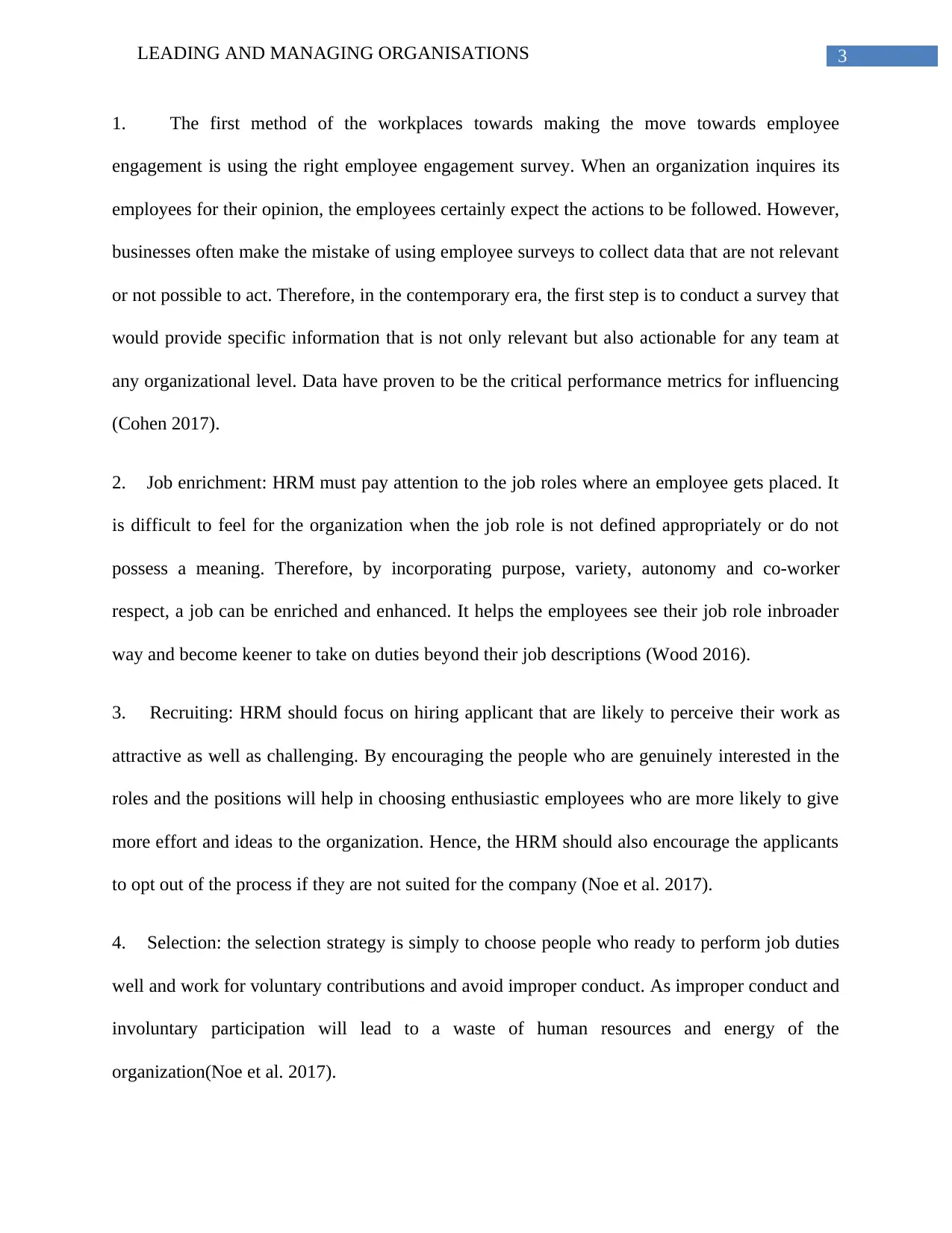
3LEADING AND MANAGING ORGANISATIONS
1. The first method of the workplaces towards making the move towards employee
engagement is using the right employee engagement survey. When an organization inquires its
employees for their opinion, the employees certainly expect the actions to be followed. However,
businesses often make the mistake of using employee surveys to collect data that are not relevant
or not possible to act. Therefore, in the contemporary era, the first step is to conduct a survey that
would provide specific information that is not only relevant but also actionable for any team at
any organizational level. Data have proven to be the critical performance metrics for influencing
(Cohen 2017).
2. Job enrichment: HRM must pay attention to the job roles where an employee gets placed. It
is difficult to feel for the organization when the job role is not defined appropriately or do not
possess a meaning. Therefore, by incorporating purpose, variety, autonomy and co-worker
respect, a job can be enriched and enhanced. It helps the employees see their job role inbroader
way and become keener to take on duties beyond their job descriptions (Wood 2016).
3. Recruiting: HRM should focus on hiring applicant that are likely to perceive their work as
attractive as well as challenging. By encouraging the people who are genuinely interested in the
roles and the positions will help in choosing enthusiastic employees who are more likely to give
more effort and ideas to the organization. Hence, the HRM should also encourage the applicants
to opt out of the process if they are not suited for the company (Noe et al. 2017).
4. Selection: the selection strategy is simply to choose people who ready to perform job duties
well and work for voluntary contributions and avoid improper conduct. As improper conduct and
involuntary participation will lead to a waste of human resources and energy of the
organization(Noe et al. 2017).
1. The first method of the workplaces towards making the move towards employee
engagement is using the right employee engagement survey. When an organization inquires its
employees for their opinion, the employees certainly expect the actions to be followed. However,
businesses often make the mistake of using employee surveys to collect data that are not relevant
or not possible to act. Therefore, in the contemporary era, the first step is to conduct a survey that
would provide specific information that is not only relevant but also actionable for any team at
any organizational level. Data have proven to be the critical performance metrics for influencing
(Cohen 2017).
2. Job enrichment: HRM must pay attention to the job roles where an employee gets placed. It
is difficult to feel for the organization when the job role is not defined appropriately or do not
possess a meaning. Therefore, by incorporating purpose, variety, autonomy and co-worker
respect, a job can be enriched and enhanced. It helps the employees see their job role inbroader
way and become keener to take on duties beyond their job descriptions (Wood 2016).
3. Recruiting: HRM should focus on hiring applicant that are likely to perceive their work as
attractive as well as challenging. By encouraging the people who are genuinely interested in the
roles and the positions will help in choosing enthusiastic employees who are more likely to give
more effort and ideas to the organization. Hence, the HRM should also encourage the applicants
to opt out of the process if they are not suited for the company (Noe et al. 2017).
4. Selection: the selection strategy is simply to choose people who ready to perform job duties
well and work for voluntary contributions and avoid improper conduct. As improper conduct and
involuntary participation will lead to a waste of human resources and energy of the
organization(Noe et al. 2017).
Paraphrase This Document
Need a fresh take? Get an instant paraphrase of this document with our AI Paraphraser
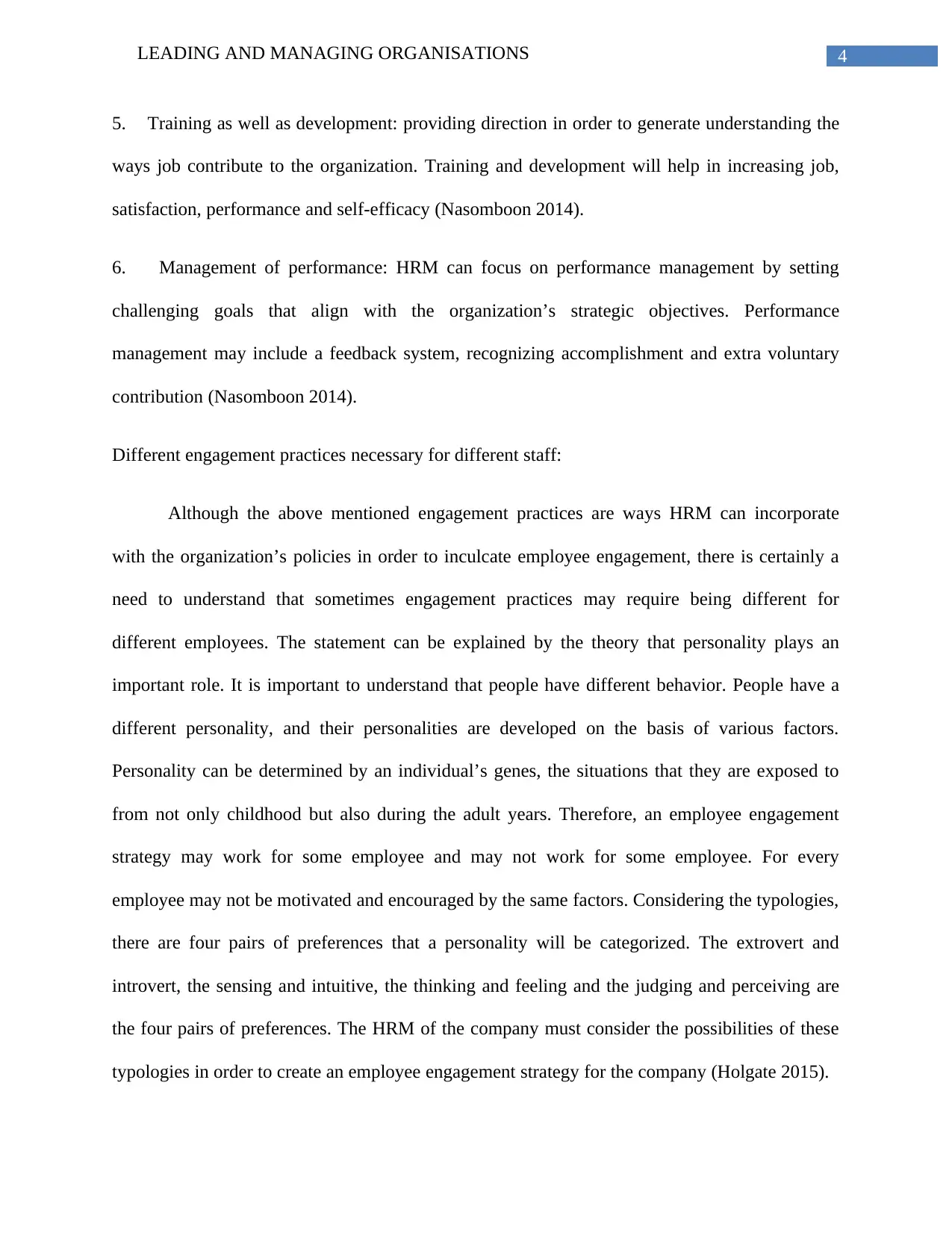
4LEADING AND MANAGING ORGANISATIONS
5. Training as well as development: providing direction in order to generate understanding the
ways job contribute to the organization. Training and development will help in increasing job,
satisfaction, performance and self-efficacy (Nasomboon 2014).
6. Management of performance: HRM can focus on performance management by setting
challenging goals that align with the organization’s strategic objectives. Performance
management may include a feedback system, recognizing accomplishment and extra voluntary
contribution (Nasomboon 2014).
Different engagement practices necessary for different staff:
Although the above mentioned engagement practices are ways HRM can incorporate
with the organization’s policies in order to inculcate employee engagement, there is certainly a
need to understand that sometimes engagement practices may require being different for
different employees. The statement can be explained by the theory that personality plays an
important role. It is important to understand that people have different behavior. People have a
different personality, and their personalities are developed on the basis of various factors.
Personality can be determined by an individual’s genes, the situations that they are exposed to
from not only childhood but also during the adult years. Therefore, an employee engagement
strategy may work for some employee and may not work for some employee. For every
employee may not be motivated and encouraged by the same factors. Considering the typologies,
there are four pairs of preferences that a personality will be categorized. The extrovert and
introvert, the sensing and intuitive, the thinking and feeling and the judging and perceiving are
the four pairs of preferences. The HRM of the company must consider the possibilities of these
typologies in order to create an employee engagement strategy for the company (Holgate 2015).
5. Training as well as development: providing direction in order to generate understanding the
ways job contribute to the organization. Training and development will help in increasing job,
satisfaction, performance and self-efficacy (Nasomboon 2014).
6. Management of performance: HRM can focus on performance management by setting
challenging goals that align with the organization’s strategic objectives. Performance
management may include a feedback system, recognizing accomplishment and extra voluntary
contribution (Nasomboon 2014).
Different engagement practices necessary for different staff:
Although the above mentioned engagement practices are ways HRM can incorporate
with the organization’s policies in order to inculcate employee engagement, there is certainly a
need to understand that sometimes engagement practices may require being different for
different employees. The statement can be explained by the theory that personality plays an
important role. It is important to understand that people have different behavior. People have a
different personality, and their personalities are developed on the basis of various factors.
Personality can be determined by an individual’s genes, the situations that they are exposed to
from not only childhood but also during the adult years. Therefore, an employee engagement
strategy may work for some employee and may not work for some employee. For every
employee may not be motivated and encouraged by the same factors. Considering the typologies,
there are four pairs of preferences that a personality will be categorized. The extrovert and
introvert, the sensing and intuitive, the thinking and feeling and the judging and perceiving are
the four pairs of preferences. The HRM of the company must consider the possibilities of these
typologies in order to create an employee engagement strategy for the company (Holgate 2015).
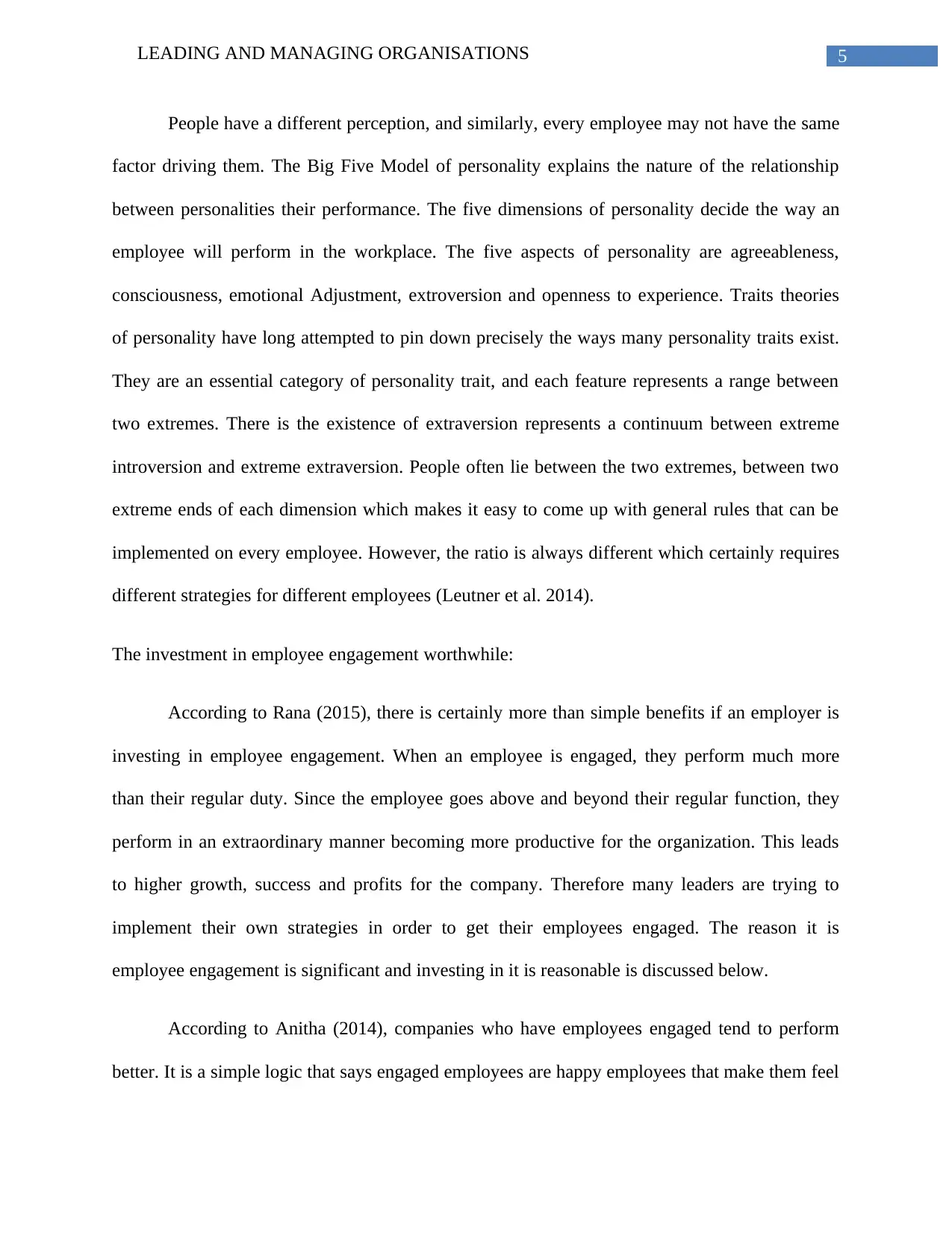
5LEADING AND MANAGING ORGANISATIONS
People have a different perception, and similarly, every employee may not have the same
factor driving them. The Big Five Model of personality explains the nature of the relationship
between personalities their performance. The five dimensions of personality decide the way an
employee will perform in the workplace. The five aspects of personality are agreeableness,
consciousness, emotional Adjustment, extroversion and openness to experience. Traits theories
of personality have long attempted to pin down precisely the ways many personality traits exist.
They are an essential category of personality trait, and each feature represents a range between
two extremes. There is the existence of extraversion represents a continuum between extreme
introversion and extreme extraversion. People often lie between the two extremes, between two
extreme ends of each dimension which makes it easy to come up with general rules that can be
implemented on every employee. However, the ratio is always different which certainly requires
different strategies for different employees (Leutner et al. 2014).
The investment in employee engagement worthwhile:
According to Rana (2015), there is certainly more than simple benefits if an employer is
investing in employee engagement. When an employee is engaged, they perform much more
than their regular duty. Since the employee goes above and beyond their regular function, they
perform in an extraordinary manner becoming more productive for the organization. This leads
to higher growth, success and profits for the company. Therefore many leaders are trying to
implement their own strategies in order to get their employees engaged. The reason it is
employee engagement is significant and investing in it is reasonable is discussed below.
According to Anitha (2014), companies who have employees engaged tend to perform
better. It is a simple logic that says engaged employees are happy employees that make them feel
People have a different perception, and similarly, every employee may not have the same
factor driving them. The Big Five Model of personality explains the nature of the relationship
between personalities their performance. The five dimensions of personality decide the way an
employee will perform in the workplace. The five aspects of personality are agreeableness,
consciousness, emotional Adjustment, extroversion and openness to experience. Traits theories
of personality have long attempted to pin down precisely the ways many personality traits exist.
They are an essential category of personality trait, and each feature represents a range between
two extremes. There is the existence of extraversion represents a continuum between extreme
introversion and extreme extraversion. People often lie between the two extremes, between two
extreme ends of each dimension which makes it easy to come up with general rules that can be
implemented on every employee. However, the ratio is always different which certainly requires
different strategies for different employees (Leutner et al. 2014).
The investment in employee engagement worthwhile:
According to Rana (2015), there is certainly more than simple benefits if an employer is
investing in employee engagement. When an employee is engaged, they perform much more
than their regular duty. Since the employee goes above and beyond their regular function, they
perform in an extraordinary manner becoming more productive for the organization. This leads
to higher growth, success and profits for the company. Therefore many leaders are trying to
implement their own strategies in order to get their employees engaged. The reason it is
employee engagement is significant and investing in it is reasonable is discussed below.
According to Anitha (2014), companies who have employees engaged tend to perform
better. It is a simple logic that says engaged employees are happy employees that make them feel
⊘ This is a preview!⊘
Do you want full access?
Subscribe today to unlock all pages.

Trusted by 1+ million students worldwide
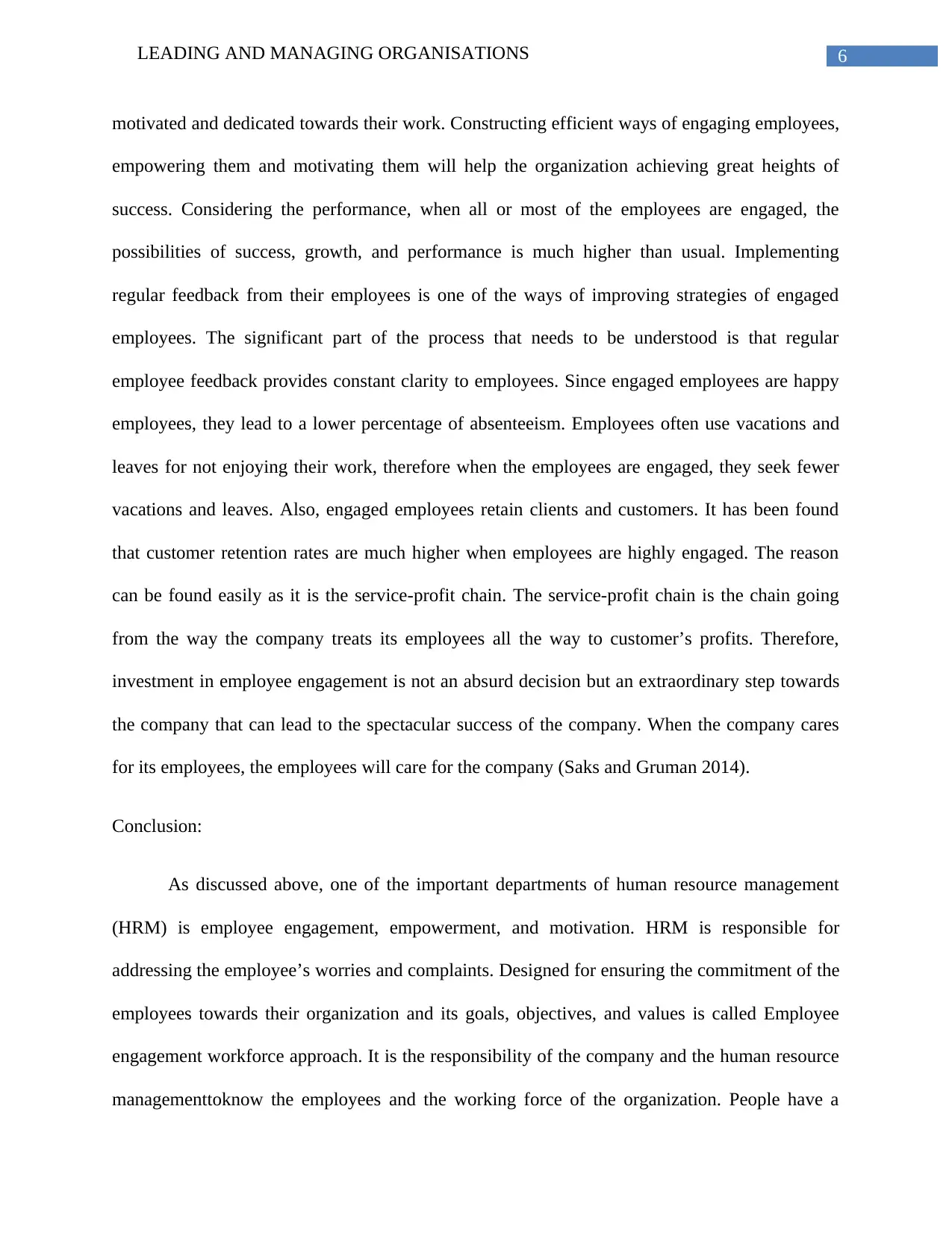
6LEADING AND MANAGING ORGANISATIONS
motivated and dedicated towards their work. Constructing efficient ways of engaging employees,
empowering them and motivating them will help the organization achieving great heights of
success. Considering the performance, when all or most of the employees are engaged, the
possibilities of success, growth, and performance is much higher than usual. Implementing
regular feedback from their employees is one of the ways of improving strategies of engaged
employees. The significant part of the process that needs to be understood is that regular
employee feedback provides constant clarity to employees. Since engaged employees are happy
employees, they lead to a lower percentage of absenteeism. Employees often use vacations and
leaves for not enjoying their work, therefore when the employees are engaged, they seek fewer
vacations and leaves. Also, engaged employees retain clients and customers. It has been found
that customer retention rates are much higher when employees are highly engaged. The reason
can be found easily as it is the service-profit chain. The service-profit chain is the chain going
from the way the company treats its employees all the way to customer’s profits. Therefore,
investment in employee engagement is not an absurd decision but an extraordinary step towards
the company that can lead to the spectacular success of the company. When the company cares
for its employees, the employees will care for the company (Saks and Gruman 2014).
Conclusion:
As discussed above, one of the important departments of human resource management
(HRM) is employee engagement, empowerment, and motivation. HRM is responsible for
addressing the employee’s worries and complaints. Designed for ensuring the commitment of the
employees towards their organization and its goals, objectives, and values is called Employee
engagement workforce approach. It is the responsibility of the company and the human resource
managementtoknow the employees and the working force of the organization. People have a
motivated and dedicated towards their work. Constructing efficient ways of engaging employees,
empowering them and motivating them will help the organization achieving great heights of
success. Considering the performance, when all or most of the employees are engaged, the
possibilities of success, growth, and performance is much higher than usual. Implementing
regular feedback from their employees is one of the ways of improving strategies of engaged
employees. The significant part of the process that needs to be understood is that regular
employee feedback provides constant clarity to employees. Since engaged employees are happy
employees, they lead to a lower percentage of absenteeism. Employees often use vacations and
leaves for not enjoying their work, therefore when the employees are engaged, they seek fewer
vacations and leaves. Also, engaged employees retain clients and customers. It has been found
that customer retention rates are much higher when employees are highly engaged. The reason
can be found easily as it is the service-profit chain. The service-profit chain is the chain going
from the way the company treats its employees all the way to customer’s profits. Therefore,
investment in employee engagement is not an absurd decision but an extraordinary step towards
the company that can lead to the spectacular success of the company. When the company cares
for its employees, the employees will care for the company (Saks and Gruman 2014).
Conclusion:
As discussed above, one of the important departments of human resource management
(HRM) is employee engagement, empowerment, and motivation. HRM is responsible for
addressing the employee’s worries and complaints. Designed for ensuring the commitment of the
employees towards their organization and its goals, objectives, and values is called Employee
engagement workforce approach. It is the responsibility of the company and the human resource
managementtoknow the employees and the working force of the organization. People have a
Paraphrase This Document
Need a fresh take? Get an instant paraphrase of this document with our AI Paraphraser
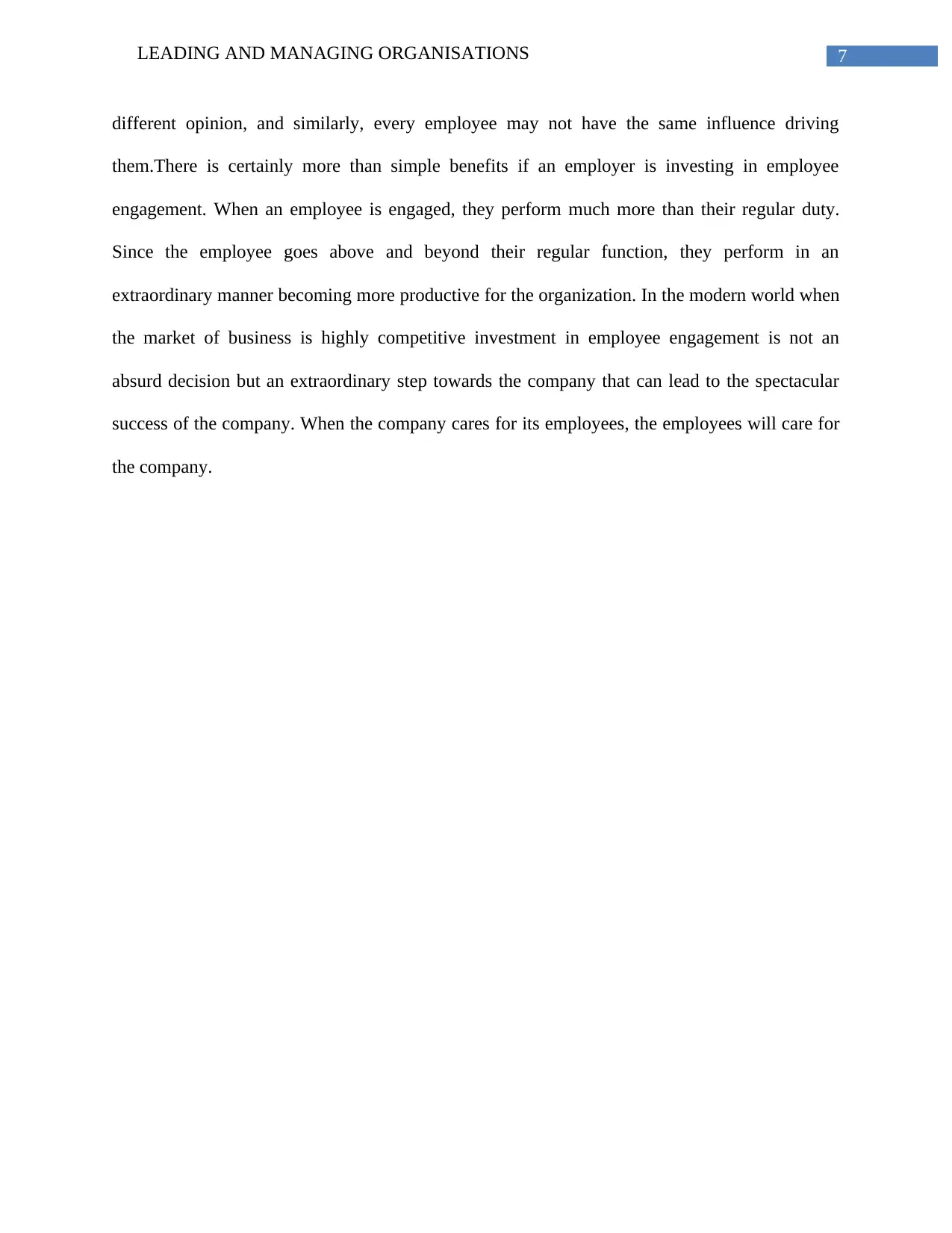
7LEADING AND MANAGING ORGANISATIONS
different opinion, and similarly, every employee may not have the same influence driving
them.There is certainly more than simple benefits if an employer is investing in employee
engagement. When an employee is engaged, they perform much more than their regular duty.
Since the employee goes above and beyond their regular function, they perform in an
extraordinary manner becoming more productive for the organization. In the modern world when
the market of business is highly competitive investment in employee engagement is not an
absurd decision but an extraordinary step towards the company that can lead to the spectacular
success of the company. When the company cares for its employees, the employees will care for
the company.
different opinion, and similarly, every employee may not have the same influence driving
them.There is certainly more than simple benefits if an employer is investing in employee
engagement. When an employee is engaged, they perform much more than their regular duty.
Since the employee goes above and beyond their regular function, they perform in an
extraordinary manner becoming more productive for the organization. In the modern world when
the market of business is highly competitive investment in employee engagement is not an
absurd decision but an extraordinary step towards the company that can lead to the spectacular
success of the company. When the company cares for its employees, the employees will care for
the company.
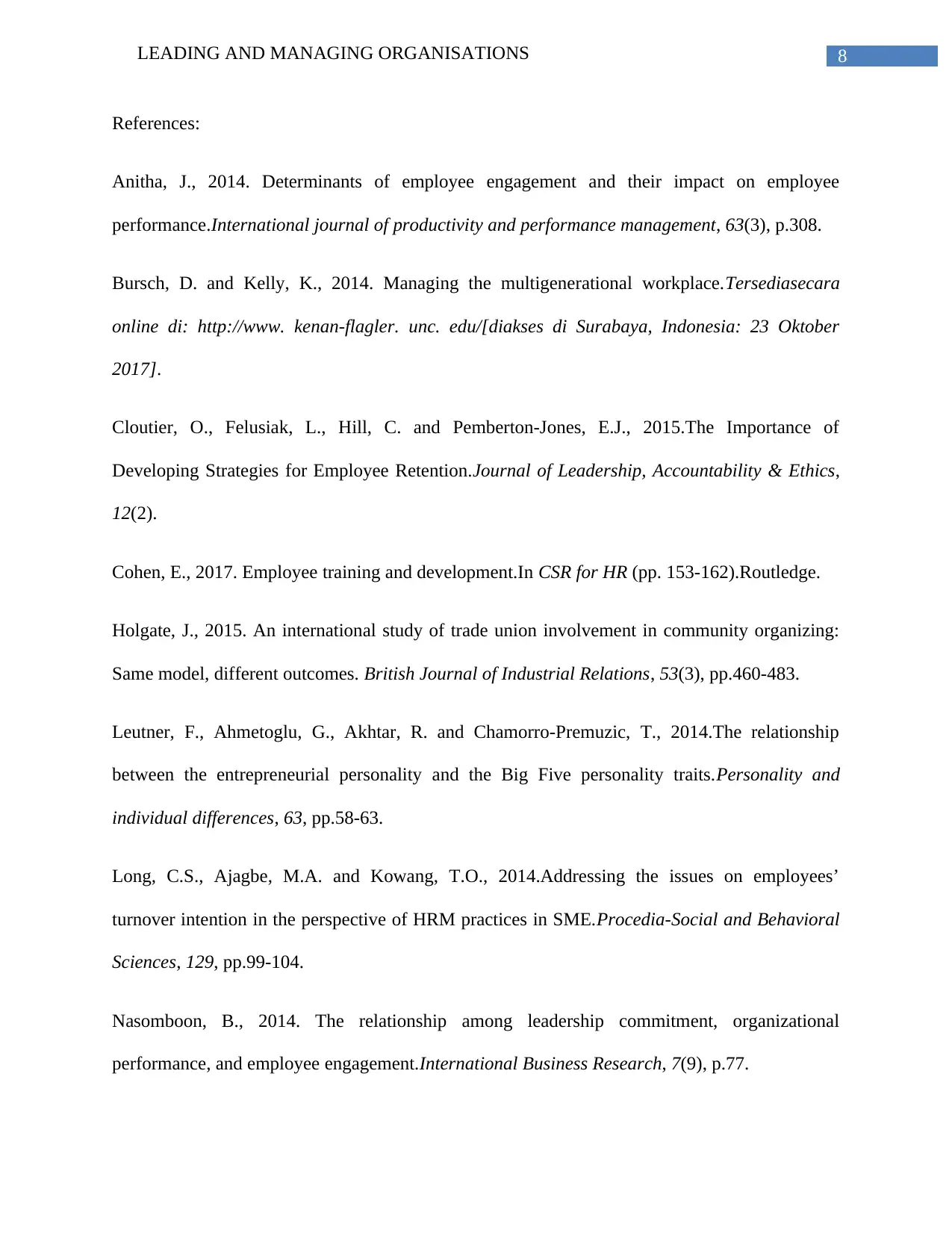
8LEADING AND MANAGING ORGANISATIONS
References:
Anitha, J., 2014. Determinants of employee engagement and their impact on employee
performance.International journal of productivity and performance management, 63(3), p.308.
Bursch, D. and Kelly, K., 2014. Managing the multigenerational workplace.Tersediasecara
online di: http://www. kenan-flagler. unc. edu/[diakses di Surabaya, Indonesia: 23 Oktober
2017].
Cloutier, O., Felusiak, L., Hill, C. and Pemberton-Jones, E.J., 2015.The Importance of
Developing Strategies for Employee Retention.Journal of Leadership, Accountability & Ethics,
12(2).
Cohen, E., 2017. Employee training and development.In CSR for HR (pp. 153-162).Routledge.
Holgate, J., 2015. An international study of trade union involvement in community organizing:
Same model, different outcomes. British Journal of Industrial Relations, 53(3), pp.460-483.
Leutner, F., Ahmetoglu, G., Akhtar, R. and Chamorro-Premuzic, T., 2014.The relationship
between the entrepreneurial personality and the Big Five personality traits.Personality and
individual differences, 63, pp.58-63.
Long, C.S., Ajagbe, M.A. and Kowang, T.O., 2014.Addressing the issues on employees’
turnover intention in the perspective of HRM practices in SME.Procedia-Social and Behavioral
Sciences, 129, pp.99-104.
Nasomboon, B., 2014. The relationship among leadership commitment, organizational
performance, and employee engagement.International Business Research, 7(9), p.77.
References:
Anitha, J., 2014. Determinants of employee engagement and their impact on employee
performance.International journal of productivity and performance management, 63(3), p.308.
Bursch, D. and Kelly, K., 2014. Managing the multigenerational workplace.Tersediasecara
online di: http://www. kenan-flagler. unc. edu/[diakses di Surabaya, Indonesia: 23 Oktober
2017].
Cloutier, O., Felusiak, L., Hill, C. and Pemberton-Jones, E.J., 2015.The Importance of
Developing Strategies for Employee Retention.Journal of Leadership, Accountability & Ethics,
12(2).
Cohen, E., 2017. Employee training and development.In CSR for HR (pp. 153-162).Routledge.
Holgate, J., 2015. An international study of trade union involvement in community organizing:
Same model, different outcomes. British Journal of Industrial Relations, 53(3), pp.460-483.
Leutner, F., Ahmetoglu, G., Akhtar, R. and Chamorro-Premuzic, T., 2014.The relationship
between the entrepreneurial personality and the Big Five personality traits.Personality and
individual differences, 63, pp.58-63.
Long, C.S., Ajagbe, M.A. and Kowang, T.O., 2014.Addressing the issues on employees’
turnover intention in the perspective of HRM practices in SME.Procedia-Social and Behavioral
Sciences, 129, pp.99-104.
Nasomboon, B., 2014. The relationship among leadership commitment, organizational
performance, and employee engagement.International Business Research, 7(9), p.77.
⊘ This is a preview!⊘
Do you want full access?
Subscribe today to unlock all pages.

Trusted by 1+ million students worldwide

9LEADING AND MANAGING ORGANISATIONS
Noe, R.A., Hollenbeck, J.R., Gerhart, B. and Wright, P.M., 2017. Human resource management:
Gaining a competitive advantage. New York, NY: McGraw-Hill Education.
Ozguner, Z. and Ozguner, M., 2014.A managerial point of view on the relationship between of
Maslow's hierarchy of needs and Herzberg's dual factor theory.International Journal of Business
and Social Science, 5(7).
Rana, S., 2015.High-involvement work practices and employee engagement.Human Resource
Development International, 18(3), pp.308-316.
Saks, A.M. and Gruman, J.A., 2014. What do we really know about employee
engagement?.Human Resource Development Quarterly, 25(2), pp.155-182.
Wood, S., 2016.High-involvement management.In Encyclopedia of Human Resource
Management. Edward Elgar Publishing Limited.
Noe, R.A., Hollenbeck, J.R., Gerhart, B. and Wright, P.M., 2017. Human resource management:
Gaining a competitive advantage. New York, NY: McGraw-Hill Education.
Ozguner, Z. and Ozguner, M., 2014.A managerial point of view on the relationship between of
Maslow's hierarchy of needs and Herzberg's dual factor theory.International Journal of Business
and Social Science, 5(7).
Rana, S., 2015.High-involvement work practices and employee engagement.Human Resource
Development International, 18(3), pp.308-316.
Saks, A.M. and Gruman, J.A., 2014. What do we really know about employee
engagement?.Human Resource Development Quarterly, 25(2), pp.155-182.
Wood, S., 2016.High-involvement management.In Encyclopedia of Human Resource
Management. Edward Elgar Publishing Limited.
1 out of 10
Related Documents
Your All-in-One AI-Powered Toolkit for Academic Success.
+13062052269
info@desklib.com
Available 24*7 on WhatsApp / Email
![[object Object]](/_next/static/media/star-bottom.7253800d.svg)
Unlock your academic potential
Copyright © 2020–2025 A2Z Services. All Rights Reserved. Developed and managed by ZUCOL.




